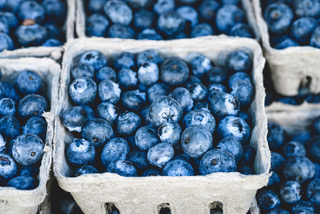Pesticides were designed to be toxic to pests and unwanted plants. Mission accomplished!
Unfortunately, many of these chemicals are also toxic to humans and wildlife. Ooops…..
Risks from pesticide exposure include respiratory problems, cancer, hormone/endocrine disorders, skin rashes, eye irritation, and even brain and nervous system toxicity.
If buying organic all the time isn’t financially realistic; or if you aren’t able to find the organic produce you are looking for, don’t panic! Experts all agree that the benefits of eating a fiber rich diet filled with whole, colorful fruits and veggies far outweighs the risks of consuming conventionally grown produce with a little pesticide residue.
Takeaway: Load up on veggies, leafy greens and fruit, no matter how they are grown.
That said, some crops are so heavily sprayed that going organic, when possible, makes good sense. A sensible general guideline when deciding whether to go organic is the thicker the outer skin or peel, the less pesticide contamination.
Produce with thick, inedible outer rinds, such as cantaloupe and butternut squash, may have lower levels of pesticide residue than those with edible, soft skin, such as berries and tomatoes. Unfortunately, pesticides are made to penetrate the outer peel and skin in order to protect the produce from the inside out, but it still makes sense that the thicker the barrier between the inner and outer layer of the fruit or vegetable, the better the protection it confers against pesticides.
Each year the Environmental Working Group (EWG), a non-profit, non-partisan organization committed to protecting human health and the environment, publishes a list of conventionally grown fruits and vegetables that have the highest and lowest pesticide residue levels remaining on fruits and vegetables after they’ve been washed. These lists are known as the “Dirty Dozen” and “Clean 15” and are valuable guides in helping you to decide when it makes sense to prioritize organic.
DIRTY DOZEN™
Strawberries
Spinach
Kale
Nectarines
Apples
Grapes
Peaches
Cherries
Pears
Tomatoes
Celery
Potatoes
Note:
Strawberries have topped the DIRTY DOZEN™ list for the past four years.
After many years off the DIRTY DOZEN™ list, Kale made a in 2019, ranking number 3 for the highest pesticide residue levels.
CLEAN 15™
Avocados
Sweet corn
Pineapples
Frozen sweet peas
Onions
Papayas
Eggplants
Asparagus
Kiwis
Cabbages
Cauliflower
Cantaloupes
Broccoli
Mushrooms
Honeydew melon
*”a small amount of sweet corn, papaya and summer squash sold in the United States is produced from Genetically Engineered (GE) seed stock. Buy organic varieties of these crops if you want to avoid Genetically Engineered produce”.(*Environmental Working Group)
Referring to these lists when grocery shopping can help you determine where it makes sense to go organic, and where it’s perfectly fine to choose conventional produce. The list changes annually, so you should check it from year to year to stay current.
To shop cleaner, download EWG’s handy Healthy Living App for more than 120,000 ratings on food and personal care products! It’s an indispensable resource, helping you to decode labels and make informed decisions about what you put in and on your body.







